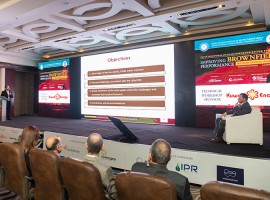Overview of key elements in enhancing human capital in Egypt’s oil and gas industry.
By Amira S. Badawey
In an industry such as the petroleum sector that spans the entire spectrum of the value chain, starting with the extraction of crude materials from beneath the surface of the earth, to delivering products to end consumers, the human element plays a unique and pivotal role. In order to meet demands for such a diverse and challenging industry, the oil and gas industry employs an array of highly capable people in various fields.
It also strives to sustain its human capital in an efficient and effective manner in order to guarantee the continued success of Egypt’s oil and gas gains that fuel industries and, therefore, are strategic to the nation’s prosperity.
In recognition of the critical contribution of human capital to the oil and gas sector, the Egyptian Ministry of Petroleum and Mineral Resources dedicated a specific dimension of its Modernization Program to the development of people within the sector and across segments under the People Agenda. Osama M. Mobarez, Undersecretary for Minister’s Technical Office at the Ministry of Petroleum, described people agenda, the 3rd Initiative of the Modernization Program as “the cornerstone and a major pillar of the modernization and development of the sector.”
The ministry’s three-year People Development Roadmap, with the slogan ‘Improve Talent Management Program,’ centers on six main pillars covering the entire gamut of human capital management functions, according to Osama El-Saadawy, Marketing Manager at Oil & Gas Skills. El-Saadawy introduced the Modernization Program’s People Agenda at the Egypt Oil&Gas’ People Development Roundtable held in mid-December 2016 and explained its key structures, processes, and mechanisms.
Crafting and Instating Talent Management
The aim of the People Agenda is to “craft and instate” a talent management program that is aligned with the Egypt’s 2016-2021 vision to “unlock the [oil and gas] sector’s full value chain potential as a growth and a sustainable development engine for Egypt.” This will be achieved though the improvement of the sector’s overall talent management processes to better equip the industry with qualified and capable workforce. As Tarek El Hadidy, Egyptian General Petroleum Corporation’s (EGPC) CEO, put it, “equipment, assets have no value without people.”
The roadmap was developed after the ministry conducted a deep dive diagnostic expedition that was carried out in October 2016 to uncover major challenges facing the petroleum community in Egypt. The results of this diagnostic analysis yielded that the oil and gas sector is currently experiencing a limited strategic role for human resources due to a lack of clear strategic direction for oil and gas people.
Furthermore, the diagnostic study showed that Egypt’s oil and gas organizations face a shortage in management potentials. El-Saadawy emphasized that it is vital for the sector to act now in order to avoid near-future leadership gaps due to lags in hiring within the executive level.
Although the sector is currently focusing on continuously strengthening technical capabilities within the upstream segment of the market, in the near future the ministry aims to ensure balanced competency development to include other areas such as gas production and petrochemicals. Stressing on the importance of inclusion during the December roundtable, EGPC’s CEO, Tarek El Hadidy, affirmed that employees in the industry, at different levels and with diverse expertise, should become a part of the overhaul agenda. He emphasized that “the oil and gas sector is not only engineers, but also technicians, administration, and accounting employees.”
Accordingly, the ministry has developed the People Agenda Initiative within the Modernization Program to remedy ailments that stem from lacking coherence in the sector’s Human Resources Management systems. The integration of performance management with competitive salary structures and incentive schemas is also lagging behind.
Therefore, the Initiative will “combine the strategic human resources (HR) approach into the process and identify different types of activities starting from acquisition and hiring to the performance evaluation and sustaining these talents,” El-Saadawy clarified the scope in his presentation.
The core of the Initiative is to address six main aspects of people development: Leadership; Talent Acquisition; Competency Development; Performance Management; Succession Planning; and Efficient HR System.
Start and End with Leadership
The sector has begun several leadership initiatives through its people development partners such as Oil & Gas Skills, with the company’s Chairman and CEO, Mohamed Badr, describing it as “the arm of the Ministry of Petroleum in developing people to work on capacity building programs across the value chain.” However, El-Saadawy called for furthermore collaboration within the sector to cover leadership capabilities at all levels, not only for top management, but also for middle-management and frontline operations.
Accordingly, under the patronage of the Minister of Petroleum, Tarek El Molla, the ministry will launch its Leadership Center of Excellence to focus on fast tracking the acceleration of leadership development of high potentials in regard to three knowledge and skill clusters based on international trends and methodologies. These clusters are context, complexity, and connectedness. They in turn will concentrate on leadership skills to safeguard emerging managerial talent with an understanding of the every changing nature of the business environment in general, and the Egyptian oil and gas sector in particular. Thus enabling them to respond to external challenges and opportunities with agility and effectiveness, survive and succeed in situations of low certainty and low agreement, while comprehending the wider economic landscape and building effective networks with concerned stakeholders.
Placing Leadership within the People Agenda is an important step, as a certain mindset with the sector’s management will be fundamental to the program. It is also chief to the success of the entire Modernization Program.
Attracting and Sustaining Talent
Hiring is one of the critical objectives for the ministry under the roadmap’s Talent Acquisition pillar.
With a population of over 90 million, there is no argument that Egypt has a wealth of people who can bolster the country’s development programs. This is even more evident in the oil and gas sector, as Egyptian universities, both public and private, offer adequate training for oil and gas engineers.
The Talent Acquisition dimension aims to develop competitive guidelines and practices to hire and retain competent staff covering the wide range of jobs and positions across different levels within the sector. The program will provide hiring guidelines together with necessary processes for restructuring competitive pay-scales, while allowing firms the “freedom-of-action” in implementing predefined measures. The roadmap will also focus on creating a five-year sectoral manpower plan in order to provide visibility on current and future recruitment needs and identify the way forward in building the sector’s human capacity. Signifying the importance of this dimension, El-Saadawy said that “this should be the way of living inside the oil and gas community.”
Competency Development
Hiring based on competency is instrumental in ensuring that the sector is employing the right people and placing them in the right place to maximize their potential. In order to achieve this, the sector must document and catalogue the desired skill-sets for various positions within the industry, while specifying the required mastery level for each position.
This will come as part of the Competency Development pillar of the roadmap. The specification of competencies is based on business needs and market trends within the framework of a competency based management (CBM) system for human resources, a framework that is adopted by international firms the world over. The skills and competencies covered by the CBM will also extend to operators and technicians, while taking into consideration the industry’s occupational health and safety regulations and guidelines.
It is paramount that the inventory of skills within the oil and gas sector remains up-to-date through accredited training programs. Accordingly, the program will work on developing a list of approved training providers across Egypt to include those in Alexandria and the Red Sea, as well as Cairo. This will guarantee quality training services, knowledge sharing among industry players, and provide learning opportunities across the sector.
Speaking on the behalf of the Minister of Petroleum during the roundtable, Eng. Mohamed Mounes, First Undersecretary for Production at the Ministry of Petroleum and Mineral Resources, said that “we aim to be a role model for other sectors in the country.” This can be achieved by providing the sector with approved CBM guidelines, where a sectoral competency dictionary can be shared with similar sectors and industries such as the Electricity and Renewable Energy.
Succeeding on Performance Management
With the right people in the right place, staff is empowered to carry out their job effectively and efficiently. In order to reach the heights of desired performance, organizations must ensure that human resources are able to utilize the inherent and acquired knowhow to the benefit of the company.
Accordingly, the Performance Management pillar will focus on cascading individual performance metrics from corporate and sectoral strategic objectives, while designing and implementing reward and recognition systems that enable and encourage high performance.
Employee evaluations and annual renumeration will be tied to the performance management system. This in turn will provide staff with comprehensive feedback on how well they are doing, in addition to giving organizations robust tools to measure their gains from investing in the collective knowledge of people through training, coaching, mentoring, and other improvement initiatives.
Succession Planning
Consequently, organizations can further map out competency gaps required to fill fundamental roles by augmenting employee capabilities with internships and development programs offered throughout the sector. However, as apparent from the diagnostic analysis, the sector’s ability to swiftly meet leadership demands is hindered by “inadequate succession planning,” as stated by El-Saadawy during his address.
“We have to build succession planning program for sustaining the pipeline of leaders, also for sustaining the middle management,” People Agenda’s Team Leader further explained. As a result, the ministry has developed a Succession Planning pillar.
Under this pillar, the ministry aims to design a two-year succession plan for the oil and gas industry. The plan will not only focus on top performers, but will encompass major roles within the industry on the executive and middle-management levels, as well as apply lessons learned from global models.
The Succession Planning pillar will also assist the ministry in sustaining talent within the industry and the country by providing employees with clear career path trajectories and competitive opportunities.
Creating Synergies and Continuity
The five pillars on which the ministry’s People Agenda is based interact and impact one another. Therefore, it is vital that the ministry creates a cohesive Human Resources Management Systems (HRMS) that promotes effectiveness, efficiency, and governance.
The sixth and final pillar, Efficient HR Governance System, will create the desired synergies and ensure the continuity of the deployed solution. Furthermore, the HRMS will extend to other aspects within organizations such as sustainability, Corporate Social Responsibility (CSR), and operational excellence.
This dimension will epitomize the ministry’s efforts into a cohesive model that will “rejuvenate” oil and gas companies in terms of jobs and positions, hierarchies and structures, accountability and empowerment, and lead to the development of profitable organizations.
The Egyptian oil and gas community, from national oil companies to international firms, agrees that Egypt has a wealth of competency and highly skilled petroleum professionals. The ministry’s three-year People Agenda confirms that “we [the Ministry of Petroleum] are planning well for the implementation,” according to El-Saadawy.
It is in the best interest of all stakeholders to work together on the continual development of sectoral human capital. Such a feat will not happen on its own or by the effort of a few. The entire oil and gas community must come together to ensure the successful implementation of the People Agenda that will be a cornerstone of the entire Modernization Program.








